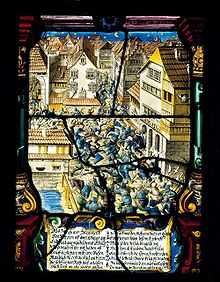- Münsterhof
-
Münsterhof Münsterhof 
Münsterhof, Zunfthaus zur Waag, to the left, Zunfthaus zur Meisen to the rightPostal code: 8001 Location: Lindenhof (quarter), Zürich, Switzerland Coordinates: 47°22′12.30″N 8°32′27.70″E / 47.370083°N 8.541028°E  Münsterhof on an 17th century glass painting, showing the "Mordnacht von Zürich" in 1350, Swiss National Museum in Zürich
Münsterhof on an 17th century glass painting, showing the "Mordnacht von Zürich" in 1350, Swiss National Museum in Zürich
 Münsterhof as seen to the north, former "Kämbel" guild house to the right, during a solidarity event of the Gesellschaft Schweizerisch-Tibetische Freundschaft respectively a visit by His Holiness, the 14th Dalai Lama in April 2010
Münsterhof as seen to the north, former "Kämbel" guild house to the right, during a solidarity event of the Gesellschaft Schweizerisch-Tibetische Freundschaft respectively a visit by His Holiness, the 14th Dalai Lama in April 2010
Münsterhof is a town square situated in the Lindenhof quarter, the historical center of Zürich, Switzerland.
Contents
Geography
Münsterhof is located in front of the Fraumünster church, to the south of the Lindenhof hill, and is surrounded by medieval buildings, among them the guild houses "zur Waag", the former "Kämbel" guild house and, as of today, the art museum Zunfthaus zur Meisen.
Being the biggest town square within the former medieval town walls in the Altstadt of Zürich, situated on the left shore of the Limmat river, the square is accessibly by Stadthausquai, Poststrasse, Storchengasse and Waaggasse, and by the Münsterbrücke crossing the Limmat river to Limmatquai.
History
In the early Middle Ages, the Münsterhof (literally: Fraumünster abbey courtyard) area was a swampy, by the Sihl river flooded hollow. First mentioned in 1221 AD, probably in the 9th century wooden houses were built by Zürich citizens besides Fraumünster Abbey and mansions made of stone may been built in early 13th century.
In medieval times, the plaza was also used as a cemetery close to the former Fraumünster Abbey, and the bailiff's house of the Einsiedeln Abbey may been situated there. In 1504 AD, and probably much earlier, the passion play of the city's martyrs Felix and Regula was celebrated on the plaza. Following the Reformation in Switzerland, the area was used as a pig market to 1667. In 1676 the town square was renewed by using cobblestones. From 1627 to 1835, along the north wall of Fraumünster church stalls were situated. In 1766 a fountain adorned Münsterhof plaza, but was removed 45 years later. During Züriputsch in September 1839, led by Bernhard Hirzel, pastor of Pfäffikon, several thousand putschists stormed the city from the west, and fought the cantonal troops in the alleys between Paradeplatz and Münsterhof. In 1938 the plaza was rebuilt at its south-westerly side towards Poststrasse as it is today,[1] now mainly being a parking facility nearby the pedestrian zones at Bahnhofstrasse, Paradeplatz and Limmatquai.
Activities and sights
Main sights are the Fraumünster church (first mentioned in 853 AD) and Zunfthaus zur Meisen that houses the porcelain and faience collection of the Swiss National Museum. There are some renown restaurants and cafés situated there among them Zunfthaus zur Waag respectively Zeughauskeller and Sprüngli at nearby Paradeplatz.
The city's authorities plan to declare Münsterhof as car-free zone: For the future public use of this urban square, an evaluation will be done, to enliven this historical place within the Altstadt of Zürich, as before, by major events such as several popular open-air performances and public events in general. Construction works are planned for autumn 2011, the inauguration is scheduled for summer 2012.[2]
Gallery
-
Fraumünster, Münsterhof and Zunfthaus zur Meisen as seen from Grossmünster
References
External links
 Media related to Münsterhof (Zürich) at Wikimedia CommonsCategories:
Media related to Münsterhof (Zürich) at Wikimedia CommonsCategories:- Buildings and structures in Zurich
- History of Zurich
- Altstadt (Zurich)
- Town squares
-
Wikimedia Foundation. 2010.



